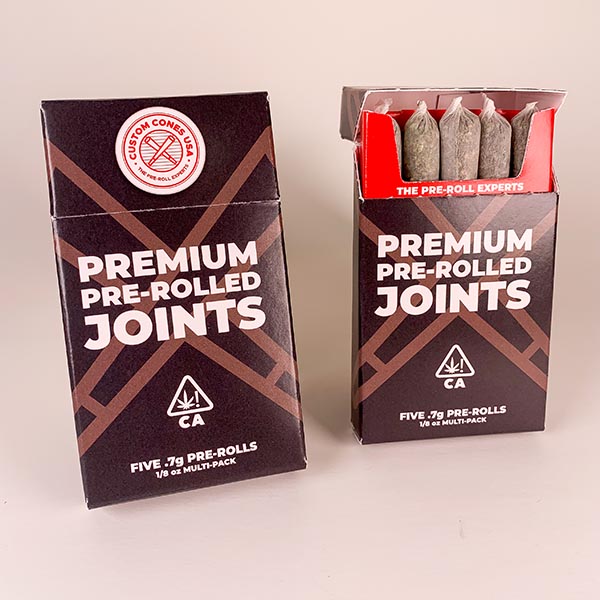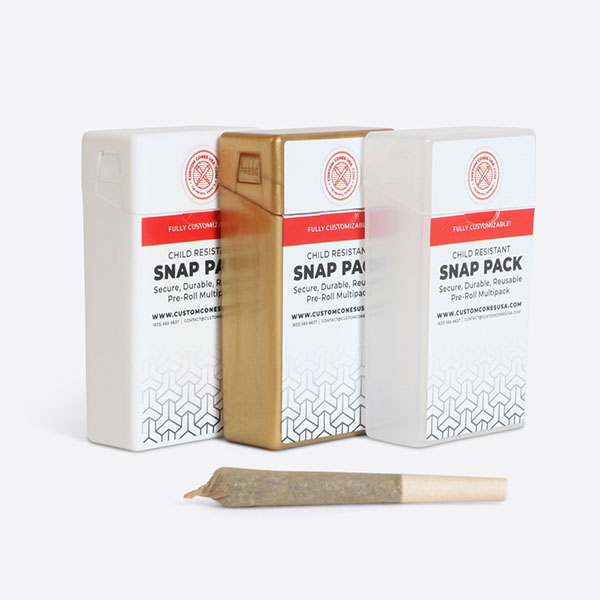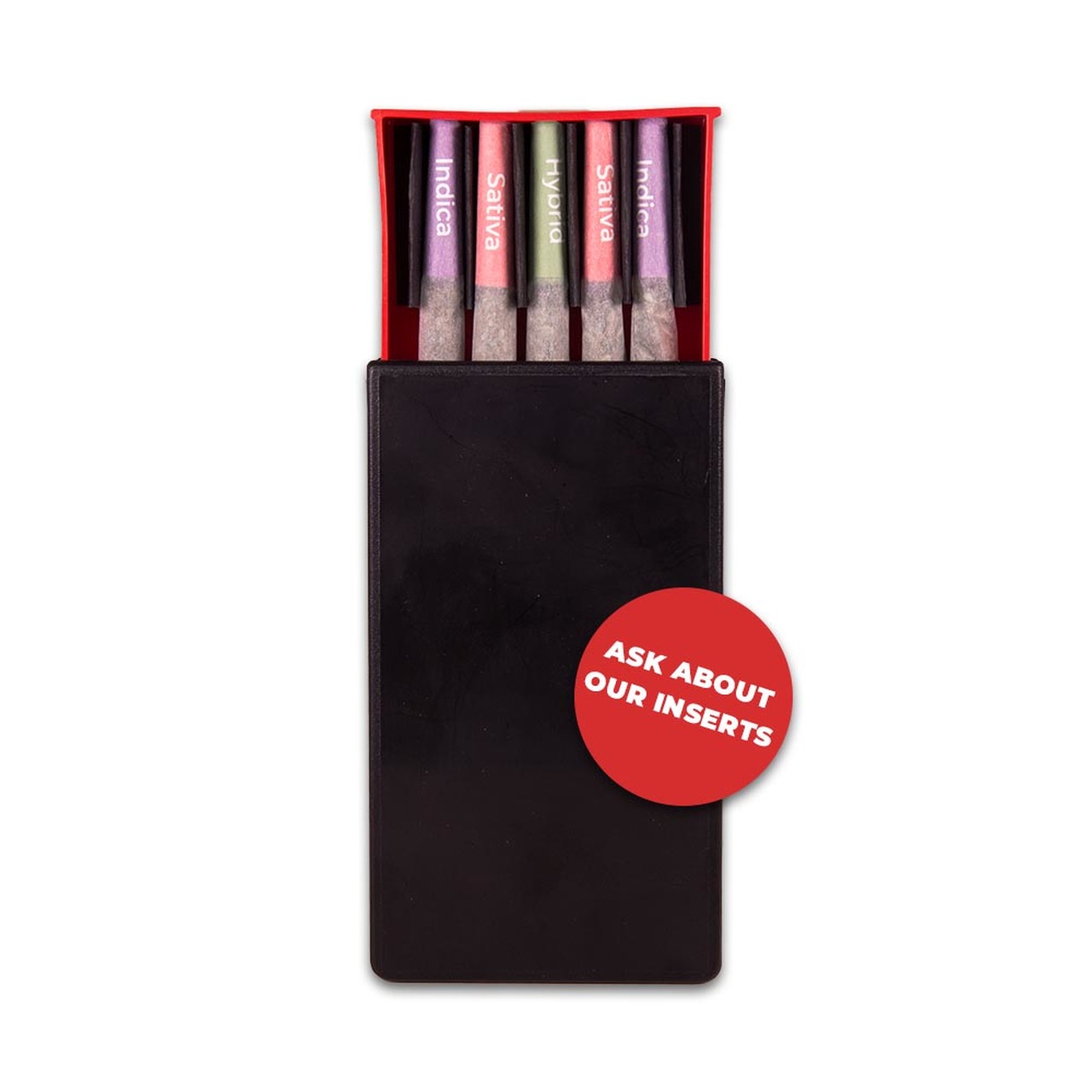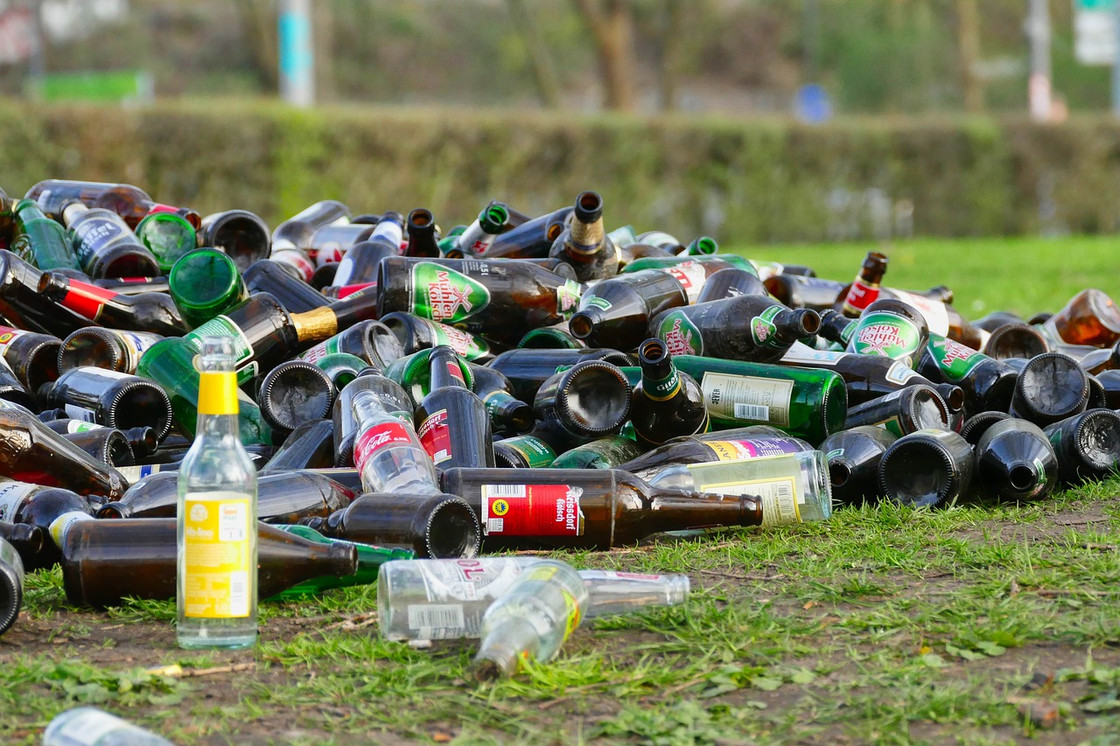Top Environmentally Friendly Pre-Roll Packaging Options
Posted by Custom Cones USA on May 19th 2020
The decriminalized hemp and cannabis industries are here and they are booming! New legislation is constantly being introduced in different regions across the globe aimed at making cannabis and hemp legal consumer products and commodities. As the industries continue to grow, more and more consumer packaging is being used and efforts toward sustainable/environmentally friendly practices have also been on the rise.
More and more cannabis companies are becoming aware of the environmental impact of their business practices. Cannabis companies can reduce environmental harm by choosing to use eco-friendly packaging to contain, market, and sell their products. Eco-friendly packaging alternatives provide a wide range of opportunities for companies looking to take steps toward sustainability. However, eco-friendly isn’t always cost-friendly. Changing packaging, redesigning, resourcing, and retooling supply chains all cost precious time and money. There are also many packaging rules and regulations imposed by local governments that make it even more difficult for companies to offer eco-friendly packaging options. Moreover, the reason plastic packaging become so popular was because it was such a cheap alternative!
Although transitioning to eco-friendly packaging presents immediate challenges to businesses, there is a shift in consumer buying behavior that offers a unique opportunity for those who are willing to take the leap. Consumers believe it’s important for companies to design and sell products that are meant to be reused or recycled and they’re willing to pay more for these products. Companies can develop stronger and more loyal relationships with their customers through transparency and the intention to make decisions that are better for the environment. Using packaging made from materials that are recyclable, biodegradable, compostable, or post-consumer recycled will prove to consumers that a company is making an effort toward sustainability.

Push Pack - Child Resistant Pre-Roll Multi-Pack
The Push Pack is an ideal package for those that are looking to make pre-roll multi-packs in sturdy, durable, eco-friendly packaging. Compared to other pre-roll multi pack options, the Push Pack is made from paper, so it is naturally environmentally friendly. Best of all, this eco friendly packaging is certified child resistant. You can completely customize the printing on the push pack to reflect your branding!
The most common sizes of the Push Pack are for five to seven pre-rolls, but we can alter the dimensions to suit all of your needs. Other popular pre roll multi pack options are 3-packs or 10-packs! Custom CMYK and premium printing provides the capacity to utilize the entire package to educate consumers about your product, attach your UPCs and regulatory graphics, and add whatever design elements you need.
The inner tray can be customized with a divider insert for alternative lighting methods like hemp wicks and matches. The option to place a match strike strip can take your custom packaging to the next level. The quality, durability, and convenience offer customers reusability that will last for months!


Cigarette Style Boxes
Made in the USA, our fully customizable cigarette boxes can be produced in any size and stock size with all natural, biodegradable paper. Since custom cigarette boxes are made from paper, they are much more environmentally friendly than their plastic or metal counter parts.
Custom cigarette boxes can be made in any size, so it is a perfect fit for your exact pre-roll and number of pre-rolls per pack. The most common sizes for custom cigarette boxes are 5 packs, 7 packs, 10 packs, and 20 packs. The 20 pack cigarette box is the same size and shape as traditionally cigarette packs, so this is a great option if you are making cannabis or hemp cigarettes.
If you are looking for a cost effective and highly customizable pre-roll packaging option that is also eco-friendly, look no further than custom branded and printed pre-roll boxes! We also have a premium cigarette box with dividers, which will perfectly hold all your pre-rolls in place, even if your customer has only 1 left in the pack!

Recycled Ocean Plastic Joint Tubes
Compared to nearly every other pop-top joint tube, these tubes are produced entirely from plastic collected from the ocean! If you are an organic and sustainable pre-roll brand, these recycled ocean plastic tubes are perfect for you!
The recycled ocean plastic tube is a child resistant, sustainably produced packaging solution made from 100% High Density Polyethylene and classifies as #2 recyclable. It has a slightly off-white color with a textured finish that completes the sustainable look and feel of these tubes. It is completely opaque, which is ideal for pre-roll operations in states that require pre-rolls to be in a non-transparent tube, like Colorado and Rhode Island.
The recycled ocean plastic tube comes in two different sizes; 78mm and 110mm. The 78mm size snugly fits two 84mm pre-rolled cones, while the 110mm size can fit a pair of any of our standard pre-rolled cone sizes. We highly recommend pairing them with our sustainably sourced, 100% organic hemp pre-rolled cones to complete your sustainable pre-roll line.
Glass Pre-Roll Tubes
Our recyclable glass tubes offer a sleek and premium feel to your customers while maximizing shelf life with a better seal for freshness than most plastic tubes on the market. Glass is an inert material, which means it does not impart anything on the product inside! This is more important for liquids, but glass is also a better oxygen and moisture barrier, compared to certain plastics.
The glass tubes are a high quality option and are offered in multiple sizes and cap styles. Cork is a natural, recyclable and biodegradable material that can be paired with our glass tubes to give your customers a 100% recyclable packaging option that’s convenient and reusable. There is also a certified child resistant cap for companies operating in states with CR regulations. The last step to compete your pre-roll packaging is a custom label or box to carefully hold all your pre-roll tubes.

Pre-Roll Snap Pack and CR-Slider Box
The Snap Pack and Child Resistant Slider Boxes are high quality, child resistant, plastic containers, which are made in the USA and offer customers great reusability.
The Pre-Roll Snap Pack is made from durable plastic that protects the pre-rolls inside from any damage. The container is reusable with a hinge that can last for many months. Consumers can reuse the container for storage of pre-rolls, lighters, hemp wicks, etc. This pre-roll package also has space for labeling on the top lid, bottom, and all across the front, back and side of the package to provide cannabis companies plenty of room for branding and information.
If you are looking for custom branded, child-safe pre-roll packaging, there are many ways to customize our child-safe slider box. You can order perfectly sized custom printed labels for your pre roll packing or add an eco-friendly paper sleeve or box! A paper sleeve is a great way to take our child safe slider box and turn it into a beautiful pre-roll multi pack. With four sides available for custom printing, you can easily showcase your unique brand and highlight the difference of your pre-roll multi-packs.

In 1987, America’s landfills became so cluttered, a floating landfill known infamously as the “garbage barge” made headlines for wandering shorelines for months looking for a place to dump trash.
In 2007, San Francisco banned non-biodegradable plastic bags in its large grocery stores and pharmacies in an effort to combat the environmental harm of these non-recyclable synthetic materials.
By 2014, 100 billion plastic bags were being used in the US each year, almost 1 per person, per day. We can literally see the toll it takes on our wildlife and environment with the countless amount of plastic bags and bottles floating around in our streets and waterways.
Only 1/5 of all plastics produced get recycled, while most plastic ends up in landfills, where it takes on average 1000 years to decompose.
Using synthetic polymers has pros and cons for both consumers and businesses alike. Businesses realize the feasibility associated with using synthetic polymers like plastics and consumers are becoming increasingly aware of the health and environmental risks that come with purchasing products made from these materials.
Ultimately, it is up to each of these parties to weigh the options and determine what makes the most sense for them.
With initiatives decriminalizing the cultivation, sale and use of cannabis and hemp being introduced around the globe, newly developing industries must consider how their packaging is produced and what their customer base will think of the processes, materials, and lifecycle. There are many new businesses that have to make packaging decisions that can be devastating if miscalculated.
Companies are deciding to forego profitability margins to ensure that they’re offering eco-friendly products to their consumers and cannabis-centric packaging companies are looking to capitalize on these businesses with responsibly sourced and sustainable packaging solutions.
How did plastic become so abundant?
Plastic is a word used most often used to describe synthetic polymers. Polymers are substances with a molecular structure composed of many repeating units bonded together. Polymers are everywhere and not all of them are synthetic. There are biological polymers like DNA and protein. There are other natural polymers like cotton, wool and silk. There are also man-made or synthetic polymers like Polypropylene (PP), Polyethylene Terephthalate (PET), and Polyvinyl Chloride (PVC). The difference between these polymers is at the molecular level. Small changes at the molecular level result in significant property differences of polymers and, ultimately, determine the capacity of their applications. Natural polymers have been used for thousands of years, but completely synthetic polymers are fairly new.
In 1840, Charles Goodyear invented vulcanization (crosslinking) of natural rubber, sulfur, and heat to produce a more solidified rubber material. Goodyear’s discovery redefined our understanding of rubber. Natural rubber (found in plants) is very thin, watery, and gooey before vulcanization. Nowadays, most people think of rubber as the solid, man-made, synthetic polymer developed by Goodyear, and not the more natural stuff we get from plants.
In the 1860s and 1870s, scientists including, August Kekule established the foundation of structural chemistry by deducing the structure of the Benzene Ring, showing that carbon can link with itself to form long chains. During this time, long-chain polymer molecules were not an accepted theory in science and Kekule’s discovery helped better understand how these structures work.
In 1907, Leo Baekeland was credited with producing the first completely synthetic polymer, using Phenol and Formaldehyde at high temperatures and pressure. This synthetic polymer could be formed to produce a solid and moldable product with seemingly uncapped applications. The newly discovered synthetic material could be used for many common household items that were previously made using limited resources.
During the 1920s, scientists began to accept the theory that polymers were long chains of repeated units and not colloidal aggregates of small molecules, which was the more popular understanding of the subject at the time.
Herman Staudinger used these principles to deduce the structure of polyethylene, which becomes one of the most important synthetic polymers produced. The simple structure of polyethylene made it incredibly versatile and is used to this day to produce grocery bags, shampoo bottles, and children’s toys. Staudinger’s deduction and incite of the polymer molecule became the origin of polymer science and he was awarded the Nobel Prize in 1953.
In the 1930s, Du Pont and chemist Wallace Carothers are credited for many synthetic polymer discoveries including neoprene and nylon. Silk naturally comes from insects, and there was very much a need for a man-made material that could mimic silk. Enter – Nylon, a synthetic polymer that could provide the same advantages that silk provides without dealing with insects as a resource. Nylon became the first totally synthetic fiber used in consumer products.
In 1934, Paul Flory’s Rubber Elasticity Theory as well as his Solution Theory provided even greater understanding of polymer crosslinking, mixing, and behavior. Flory showed how the thermodynamic and chemical properties at the molecular level contribute to directly define the macro-scale properties that we see after production. Flory earned the Nobel Prize for his discoveries in 1974.
During WWII, many companies manufacturing synthetic polymers provided supplies to the military. After the war ended, these companies switched gears and began manufacturing products for homes. Plastic went from protecting cargo to protecting leftovers. Americans developed a “throwaway culture”, falling in love with single-use plastics like Tupperware without understanding the consequences involved with the production and waste of such materials. During the 1960s, global plastic production grew 400% and by 1979, more plastic was produced than steel.
Why are businesses considering a different route?
Studies over the past few decades have revealed that the production, use, and waste of synthetic polymers can be harmful to humans and the environment. Consumers are more knowledgeable than ever about synthetic polymers and make purchasing decisions based on the potential health risks and environmental harm associated with certain products.
Companies new and old have a difficult decision to make: continue to utilize the more cost-effective synthetic polymers for their products or appease newly developed consumer trends that are concerned with the effects of using these materials.
Coca-Cola bottles made from Acrylonitrile (used in food and beverage containers for 3 decades) were banned in 1977 after Acrylonitrile was declared toxic.
Bisphenol A or BPA exposure was another major red flag associated with plastic-related health risks. Scientists found that it resulted in ailments that signaled problems with humans using these products. In 2010, The U.S. Food and Drug Administration changed their position on BPA from being completely safe to only being safe at low levels of human exposure, while recognizing potential effects of BPA on the brain, behavior, and prostate glands in fetuses, infants, and young children at higher levels of exposure.










